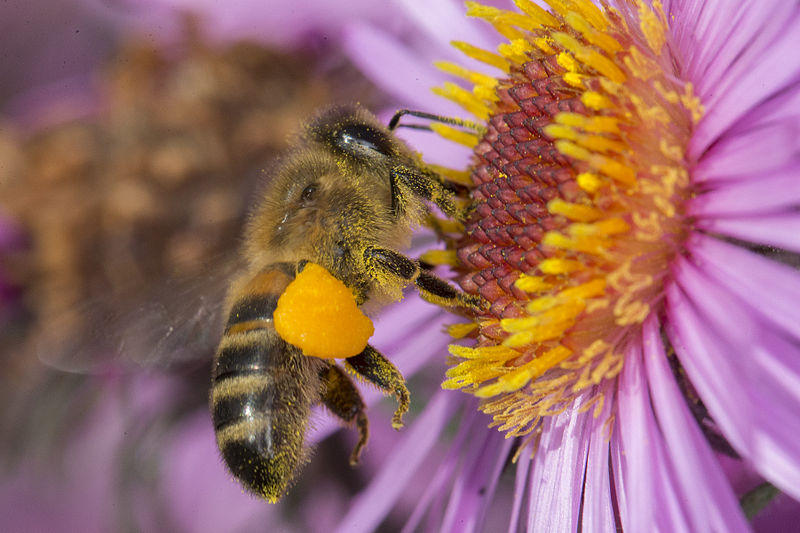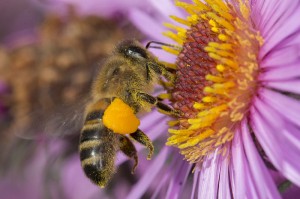As mentioned previously on the blog, Andrew Jackson and I started a new module this year called “Research Comprehension”. The module revolves around our Evolutionary Biology and Ecology seminar series and the continuous assessment for the module is in the form of blog posts discussing these seminars. We posted a selection of these earlier in the term, but now that the students have had their final degree marks we wanted to post the blogs with the best marks. This means there are more blog posts for some seminars than for others, though we’ve avoided reposting anything we’ve posted previously. We hope you enjoy reading them, and of course congratulations to all the students of the class of 2014! – Natalie
Here’s articles from Maura Judge and Chris Parsisson inspired by Professor Phil Stevenson‘s seminar, “Pollinator fidelity in coffee and citrus: is it all just sex and drugs?”
——————————————————————————
An unlikely love story
Maura Judge
This is the story of a certain love affair, commonly known as floral constancy. The story involves pollinators and flowers. Floral constancy is the tendency of a pollinator to remain faithful to and exclusively visit a certain flower species or morphospecies. Whilst remaining faithful, the pollinator bypasses other available flower species that could potentially be more rewarding.
So what are the drivers of this phenomenon? For the plant species, the benefits are more obvious as pollinators that are flower faithful are more likely to transfer pollen to other flowers of the same species and hence, flower constancy favors flower pollination. Furthermore, flower constancy prevents the loss of pollen during interspecific flights and prevents pollinators from clogging stigmas with the pollen of other flower species. Hence, the reasons for the evolution of floral constancy in plants are obvious.
However, what could be the benefits for a pollinator? To ignore other flowers that could potentially provide more nectar than their preferred type contradicts the optimal foraging theory. Nonetheless, floral constancy has been observed in honeybees (Apis mellifera), bumblebees (Bombus terrestris) and butterflies (Thymelicus flavus). Drivers of floral constancy are rewards associated with cues such as flower shape, colour or scent. For example, honeybees have been found not to attempt to feed on other available flowers that exhibit an alternative colour to their preferred flower type. One hypothesis for the evolution of floral constancy in pollinators is that insects can only identify and handle one flower type or species at a time due to their limited memory capacity.
There are three other hypotheses for the evolution of floral constancy in pollinators. The first is the learning investment hypothesis which refers to the ability of a pollinator to learn a motor skill to obtain nectar from a certain species of flower. Learning these motor skills requires a substantial investment of energy and switching to other flower species could be energetically costly and hence, inefficient and non-adaptive. Furthermore, feeding from one particular plant species increases the insect’s efficiency to obtain nectar from it. The second hypothesis is the costly information hypothesis which states that pollinators stay faithful to one plant species because they know that they obtain a reliable reward from it, i.e. nectar. Hence, the pollinator does attempt to feed on other plant species because it cannot predict the amount of nectar in other flowers and could essentially waste foraging time and energy on flowers that contain possibly less or even no nectar. The third alternate hypothesis is the resource partitioning hypothesis. It states that, in social foragers, flower constancy could benefit the entire colony as if individual foragers specialize on specific flower species, foragers avoid competing with one another. Thus floral constancy would increase foraging efficiency.
In addition, Prof. Stevenson and his colleagues have found evidence for another hypothesis in which toxins such as caffeine are the drivers of floral constancy in pollinators. Evidence for this came from bees being found to be more likely to forage on the same plant species if it contained caffeine and less likely to confuse it with similar signals from other plant species. They have found evidence of plant defence compounds enhancing the memory of reward in pollinators. Honeybees rewarded with caffeine, which occurs naturally in coffee and citrus plant species, were three times as likely to remember a learned floral scent as honeybees rewarded with sucrose alone. Thus, this proposed hypothesis ties the little understood phenomenon of floral constancy in with the little understood ecological role of plant defence compounds occurring in floral nectar.
Admittedly, this love affair is not as rosemantic (pun intended) as Romeo and Juliet’s. However, it is very intriguing nonetheless and the mechanisms behind it are still very uncertain. Exciting new evidence underlying the mechanisms involved is being found by Stevenson and his collaborators and it seems likely that it is not solely Britney Spears who finds toxicity attractive.
—————————————————————————–
The deviousness of flowers
Chris Parsisson
It should have come as no surprise to us that flowers act as drug pushers to get their evil way. Phil Stevenson of The University of Greenwich and Kew gave a short talk about the loyalty of pollinators to nectar producers.
Flowers have many devious tricks and will stop at nothing to reach their ultimate reproductive goals. A world before flowers must have been a drab place with wind pollination being the order of the day and clouds of pollen wafting across the countryside in a desperate bid to land on a female plant part and perpetuate the gene line of the parent. No colourful flowers, no enticing perfume, no sweet honey. Just a hay fever sufferer’s nightmare. No wonder some plants formed a partnership with pollinators to streamline the operation.
And what a partnership it was! Insects often took on the role of pollinators and tied their fortunes to the plants’ success as plants tied themselves to the pollinators. Flowers evolved colours and scents to attract insects then often refined their flowers for special partners. Bees and wasps became preeminent in pollination and became dependent on supplies of nectar and pollen for their living. Always lured in by the flowers their co-evolution made both mutually dependent. The beauty of flowers and scents led to human intervention and flowers were developed with multiple petals and constant flowering periods but these developments often led to sterile flowers or loss of scents the need for human pollination. Isn’t it always the way? But who is keeping score? The millions of cultivated roses grown around the world must outnumber the wild roses in hedgerows so again the inclusive fitness of the roses, originally chosen for a brighter or extra petal, was assured. We too were seduced by the flowers into serving their nefarious schemes.
We discovered in recent decades that the colour we see on a flower is not the same as that seen by many pollinators. Bees see more in the ultra violet range and the patterns they perceive on many flowers lead directly to nectaries or to the stamens for a dusting of pollen or to shed some onto the stigma in this joint effort. No wonder many cultivated flowers with their multiple petals, lack of scent and vibrant colours are inaccessible to many bees, the landing instructions are lost and the nectaries have often been sacrificed for more petals. Best leave the cultivated flowers for the humans, enthralled by the flowers’ guile.
We know that some orchids lure male bees in with the promise of quick uncomplicated sex. Like a seaport pimp enticing a sailor down an alley with promises of beautiful girls nearby, the orchid entices him in and delivers nothing. The female bee is really another co-evolved flower and the male gets nothing for his trouble. The orchid delivers its pollen onto the bee’s back and off he goes looking for another flower. The floral equivalent of robbing the sailor and sending him staggering off into the night.
Now, it seems, we find that flowers are demanding loyalty of bees by slipping them drugs without their knowledge. Small amounts of caffeine are included with the nectar at a level thought to be below the taste consciousness of the bee but enough to make it remember the hit it got and return for more. This occurs in many coffee species and also in citrus species. It makes evolutionary sense. All flowering plants are competing with every neighbouring flower. If they weren’t and there were enough pollinators to go around all flowers would be simple in form and give out a minimum amount of nectar. That’s why flower form evolved so dramatically. The cunning flowers need an extra edge to ensure that bees come back to them as long as their flower lasts. Many flowers need a pollinator to visit more than once: to take away pollen to another flower and to bring in pollen. Often the female stigma ripens at a different time to the male anthers to prevent self-fertilisation so multiple visits may be ensured by making a bee remember the little lift it got at a particular plant.
Pollination is a serious business as 65% of crops are insect pollinated. Concerns about sudden hive collapse of honey bees and losses of pollinators are real. Even the managed bees are not enough for all pollination needs so wild pollinators must be carefully watched. Large monocultures may be detrimental to bees as tests have shown that levels of amino acids in some nectar may be harmful if eaten in excess.
Many leads could follow this research as a way to best serve the pollinators but, rest assured, those devious flowers will be still full of tricks.
Image: Wikicommons


